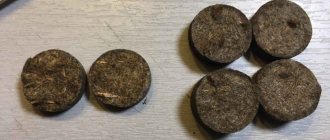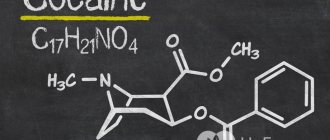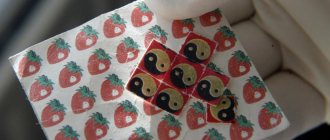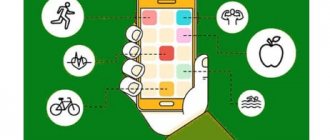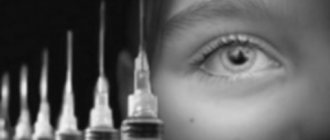According to history, the Coca-Cola drink was invented in Atlanta (Georgia, USA) on May 8, 1886. Its author is pharmacist John Stith Pemberton, a former officer in the American Confederate Army (there is a legend that it was invented by a farmer who sold his recipe to John Stith for $250, as John Stith allegedly said in one of his interviews).
The name for the new drink was invented by Pemberton's accountant Frank Robinson, who also, having mastered calligraphy, wrote the words “Coca-Cola” in beautiful curly letters, which are still the logo of the drink.
Coca-Cola for 5 cents - Coca-Cola advertising poster from the period 1890-1900
The main ingredients of Coca-Cola were as follows: three parts of coca leaves (from the same leaves in 1859, Albert Niemann isolated a special component (the drug) and called it cocaine) to one part of the nuts of the tropical cola tree. The resulting drink was patented as a medicine “for any nervous disorders” and began to be sold through a vending machine in the largest city pharmacy, Jacob's in Atlanta. Pemberton also claimed that Coca-Cola healed impotence and that those addicted to morphine could switch to it (by the way, Pemberton himself was partial to morphine). It should be noted here that cocaine was not a prohibited substance at that time, and nothing was known about its harm to health (for example, in the story “The Sign of Four” by Arthur Conan Doyle, Sherlock Holmes used cocaine in moments of inactivity that were so painful for him). Therefore, cocaine was freely sold, and it was often added for pleasure and tone to drinks instead of alcohol - Coca-Cola was not new to this.
Cocaine was recognized as a drug - Coca Cola was banned from using cocaine in the production of its drinks. As a result, Coca Cola closed its recipe making it a “Secret” and continued producing its drink, but we understand that in order to remake the entire industry and leave the same taste, replacing the ingredients in one day is impossible, and is it necessary - after all, the costs will not pay off.
Expansion of Coca cola into schools and capture of markets - ]]>https://denegibudut.ucoz.ru/blog/coca_cola_grjaznaja_pravda/2012-04-07-18721]]>
Newspaper headlines:
What is a drug
Cocaine is a drug of natural origin. It is found in coca leaves and other related plants. Most widely distributed on both American continents. This is explained by the fact that coca grows on the mountainous slopes of the tropical zone. 75% of the drug does not leave America, the remaining 25% is transported to European countries.
The plant Erythroxylum is a natural alkaloid that has a powerful effect on the human body. Initially, coca was used by the aborigines for its benefits, achieving amazing stamina and strength due to the drug. Among other things, cocaine dulled hunger, which was widely used during long marches and during protracted battles.
The use of coca leaves was also ritual in nature and was practiced by local priests, who brewed potions on holidays to maintain the morale of the people. However, the use of Erythoclylum at that time was not widespread.
Cocaine is a symbol of high morality and ethics
But the idea of the deep connection between cocaine and the high moral qualities of a doctor was most clearly expressed in The Red Bracelet, a medical detective story by Elizabeth Mead, published in 1895. "The Red Bracelet" is one story in a series dedicated to the exploits of Dr. Clifford Halifax, saving patients from mysterious diseases. They were all called “From a Doctor’s Diary,” and the writer was inspired to create them by stories about Sherlock Holmes.
So, in “The Red Bracelet,” a certain Mr. Stafford turns to Dr. Halifax, concerned about the condition of his daughter Molly, who is blind from birth. The ophthalmologists are powerless, and then the girl is fascinated by an adventurer named Basil Winchester. After a chance meeting, he literally hypnotized the girl, and she always wants to be with him, does not eat or sleep. Halifax discovers that Winchester is influencing Molly through the coral bracelet he gave her. The turning point in the case comes when the doctor realizes that the girl distinguishes light from darkness: he realizes that her eyes actually work normally. Using cocaine, Halifax performs a quick operation and removes the excess tissue from Molly's eyes. And now, when the girl has regained her sight, Winchester’s spell is broken, Molly refuses to meet with him, and gives the coral bracelet to her savior.
It is curious that the writer does not reveal the mechanism of “hypnosis” on the part of the swindler: by all indications, this is the usual desperate love of a hysterical girl (her hysteria and mood swings are emphasized in every possible way), because of which she defies her parents. “I never hoped that someone could love a blind woman!” - Molly exclaims. Under the cover of a “case history,” the detective plays out a typical bourgeois drama: an emotional girl gets involved with a man unworthy of her social status and rejects the norms of decent society.
By curing Molly of blindness, the doctor thereby removed the deep cause of her vicious passion and returned her to the right life. What role does cocaine play here? When Halifax suggests his operation, Molly's mother warily asks: does it hurt? Will I have to resort to chloroform? But the doctor reassures her: don’t be afraid, just cocaine. The writer implicitly contrasts chloroform, with its unconsciousness and erotic hallucinations of patients, as a symbol of the love spell in which Molly finds herself, and cocaine, a symbol of insight, self-control and moral purity.
Cocaine also turns out to be a material expression of educational influence on the part of the doctor. In fact, even before the operation, Halifax “heals” the girl, suppressing her whims with the power of his will: he convinces her to start eating and sleeping. Before opening her eyes during the operation, he already enlightens her with his words and convinces her to return to the virtues of the middle class. Cocaine, like the scalpel, turns out to be the embodiment of the correct morality that the doctor professes. Just as the coral bracelet tied the girl to the swindler Winchester, a drop of cocaine in the eyes broke this connection and “connected” Molly to the virtuous and healing will of the doctor.
Distribution of cocaine in Europe
The habit of chewing coca leaves, like many other things, was brought to the European continent by Spanish and Portuguese colonialists, in particular, the famous Amerigo Vespucci. Having captured the territory of what is now Peru, where there are excellent conditions for the natural growth of coca, the Spaniards gained control over plantations of the plant, making its leaves something of a currency. It was a very profitable business, and by the end of the 16th century, almost 90% of the local population had one relationship or another with the drug trade.
Naturally, the goods were also supplied to Europe. Coca leaves were used as a drug until the 19th century. Around the end of the 19th century, it was possible to isolate a pure substance from the leaves, called cocaine. Its nomenclature name is cocaine hydrochloride. It is a crystalline powder with a bitter taste and no odor.
At first, the substance was used exclusively for medical purposes. The powder was used as a local analgesic, and oral cocaine was used as a mild psychostimulant. The drug gained great popularity thanks to the famous psychoanalyst Sigmund Freud, who was a famous cocaine addict. He was able to come up with a whole system of treatment with cocaine, treating depression, chronic fatigue syndrome, and erectile dysfunction with it. Accordingly, by the beginning of the 20th century the drug became widespread.
Cocaine acts on cells of the central nervous system and cardiovascular system. It’s funny that the most popular drink in the modern world, Coca-Cola, also contained cocaine until 1906. This is where its name came from.
Ten years later, the first mention of death due to a cocaine overdose appeared. Studies have been conducted that have proven the occurrence of dependence on the drug and the presence of harmful effects from its regular use. Thus, in 1922, the substance was first included in the list of prohibited substances in a number of European countries.
The next wave of popularity came in the 70s of the last century. “Cocaine is the drug of the rich” - this was the belief in those years; the use of cocaine was a luxury and an indicator of material wealth. Many stars and public figures became addicted to drug use. Those who could not afford cocaine were content with its cheaper analogue - amphetamine, which has a similar effect on the human body and allows one to obtain approximately the same effect.
Today, as many years ago, most (approximately 70%) of cocaine produced does not leave the American continents. Tons of product are grown on the plantations, the drug business is thriving and has no plans of dying. Every year, almost 800 tons of dangerous drugs are consumed worldwide. In our country, the drug gained popularity in the 90s of the 20th century. In the last 5 years there has been a cocaine boom, and the number of cocaine addicts has increased almost 12 times.
Cocaine is a fairly expensive drug when compared with other psychostimulants (especially synthetic ones). However, drug dealers often resort to cunning, selling the first doses at a price 1.5–2 times lower than the market price in order to acquire another regular customer.
Coca-Cola is hiding the sweetener
The interregional public consumer organization “Open Association of Consumers” demanded through the court to ban the sale of Coca-Cola Light in Russia. The drink's manufacturer, the Coca-Cola Company, does not indicate on the label of its product that it contains the sweetener aspartame, the plaintiff explains. “The lawsuit is being considered in the Kuntsevo court, hearings on the case are already underway,” a representative of the Open Association of Consumers told Gazeta.Ru.
Consumer rights advocates also sent relevant requests to the head of Rospotrebnadzor, Gennady Onishchenko, and the Minister of Health, Tatyana Golikova. The Coca-Cola Company could not be reached for comment.
Aspartame is an artificial sweetener, sugar substitute (food additive E951). L-Aspartyl-L-phenylalanine methyl, decomposes in the human body into methanol and two proteinogenic amino acids: aspartic and phenylalanine….
The sugar substitute aspartame, when decomposed in our body, produces methyl alcohol, which turns into formaldehyde. Formaldehyde is a strong poison, officially recognized as a carcinogen, that is, a substance that can cause cancer.
The effect of drug use
The effect of cocaine is characterized by exorbitant pleasure, euphoria occurs, and a charge of energy and vigor appears. It seems to a person that he has discovered new abilities, super skills. However, tolerance to cocaine quickly develops, so in order to re-experience the same sensations, the addict has to increase the dose with each use. This fact largely explains the rapidly developing addiction to cocaine.
So, a person who has used a drug will feel the following:
- Euphoria. The drug addict experiences a wide range of positive emotions, his mood improves, and there are many reasons for joyful fun. The person becomes sociable and very trusting of people. An interesting fact is that cocaine addicts under the influence of substances cannot keep any secrets.
- Mental activity. The functional state of the central nervous system improves many times after using cocaine, a person better remembers what he read and saw, and solutions to difficult tasks and problems come to mind. However, after the effect ends, the addict cannot cope with even the simplest operations due to the depletion of brain activity reserves.
- A surge of energy and physical strength. Cocaine addicts experience a surge in physical activity with each dose. The need for rest and food disappears. Physical abilities seem limitless to a drug addict. True, from the outside it doesn’t look like that at all. A drug addict has poor coordination of movements and often loses his balance.
- Mental activity manifests itself in extreme determination to commit, it seems, any act or action. In a state of drug intoxication, people do not perceive critical judgments towards themselves at all. They take on several tasks at once and do not complete any of them. There is delusion of grandeur.
The physical side of taking the drug
Drugs cause enormous harm to human health, and cocaine, of course, is no exception. You need to understand how cocaine acts on the human body. The use of this drug leads to:
- active contraction of blood vessels,
- increase in body temperature,
- increased breathing and heart rate,
- the gag reflex is suppressed,
- loss of appetite occurs, as a result of which the addict loses weight (with regular use),
- with increasing dose - muscle cramps, tremor.
Overdose is characterized by depression of the respiratory center of the medulla oblongata, which can lead to respiratory arrest and ultimately death. Long-term and regular use leads to irreversible changes in brain tissue, which can cause the development of a condition close to epilepsy, also characterized by seizures and convulsions.
Large doses and regular use lead to visual and auditory hallucinations, the development of psychoses and neuroses, paranoia and depression. In this state, attempts to commit suicide are not uncommon.
The inhalation method of cocaine use is characterized by damage to the mucous membrane of the nasal cavity and the occurrence of nosebleeds.
Important! The combination of drugs and alcoholic beverages can lead to cardiac arrest. The intravenous route of administration, which is typical for heroin, is not used for cocaine use.
When inhaling cocaine, the effect appears after a quarter of an hour and lasts 30 minutes, sometimes 2-3 hours. The duration and strength of symptoms depends on the quality of the product used and the experience of the drug addict. Over time, addiction (tolerance) develops, requiring an increase in dose to achieve the same level of pleasure.
Health effects
Cocaine has a negative effect on all vital organs of the human body.
Under its influence, the drug addict’s psyche deteriorates. The brain is the first to suffer. Symptoms of brain disorders:
- increased fatigue;
- inability to think abstractly;
- memory impairment;
- tightness of emotions;
- persistent headaches;
- trembling in the limbs;
- sleep disorders;
- epileptic seizures.
The brain is affected by drugs, regardless of how the drug enters the body. The types of pathologies of internal organs depend on the method of administration.
Painful effects of cocaine use:
- cardiac ischemia;
- myocardial infarction, stroke;
- psychoses;
- metabolic disease;
- violation of the septum between the nostrils, leading to facial asymmetry;
- nosebleeds, runny nose, hoarseness;
- loss of smell and taste;
- asthma, pulmonary failure, pneumonia and other diseases of the respiratory system;
- hemoptysis;
- infertility;
- impotence;
- anorexia;
- Gastrointestinal diseases (ulcers, pancreatitis, gastritis).
Cocaine addiction can be fatal.
Causes of death:
- heart attack;
- malignant hyperthermia;
- epilepsy;
- severe arrhythmia;
- renal failure;
- multiple internal bleeding;
- cerebrovascular accidents.
Regular use of cocaine requires an increase in dosage, increases intoxication of the body, turning a healthy person into a disabled person.
What does a cocaine addict look like?
It is very easy to recognize a person who uses drugs by their appearance. Lifestyle, manners, mood and character also change. Carelessness in clothing, excessive self-confidence, etc. often appear. So, physically, cocaine use is manifested by the following signs:
- pupil dilation,
- pale skin,
- hyperhidrosis,
- increase in breathing rate and heart rate,
- chills,
- gastrointestinal disorders,
- decreased immunity and, as a result, susceptibility to infectious diseases,
- fever,
- tremor,
- hyperactivity,
- lost look,
- toxic rhinitis,
- regular rhinal bleeding.
Dependence leads to the development of seizures and muscle cramps. The addict quickly loses weight and overall healthy appearance. The eyes become inflamed from constant lack of sleep. The patient does not care about his appearance and looks unkempt.
How does cocaine addiction develop?
A person becomes mentally addicted to the drug after the first use. After 5-6 doses it acquires a pronounced character. It seems to a person that without a drug he will not be happy. This triggers the need for the next dose.
Signs of physical dependence occur after regularly taking 10-15 doses of the drug. Drug addicts who inhale powder experience withdrawal faster than those who smoke crack or inject the drug intravenously.
Withdrawal syndrome (abstinence syndrome) occurs when you stop taking drugs and is expressed in a deterioration in a person’s physical and mental condition.
The mental aspect of cocaine use
From a mental point of view, cocaine use is characterized by the following:
- a cocaine addict often feels like insects are crawling on him, so he scratches his face and the skin of his hands until he bleeds,
- mood swings: from euphoria to aggression,
- extreme self-confidence
- chronic insomnia,
- lethargy and irritability.
Once hooked on cocaine, a person slowly sinks to the social bottom. He has money problems. He starts selling things from home, borrowing money, stealing. The patient becomes secretive and pathologically deceitful. Accordingly, such people need the help of a professional narcologist or psychotherapist. After all, it is almost impossible to stop using a substance on your own. Withdrawal syndrome (withdrawal, withdrawal) is manifested by terrible physical symptoms:
- nausea and vomiting,
- cluster headaches,
- fever,
- aches in muscles and joints,
- cardiac arrhythmia.
However, the psychological side of the process causes the greatest torment. An addicted person experiences depression and depression, a desire to isolate himself from the whole world, and panic attacks occur. A person constantly wants to feel the drug effect again, and he is ready to do almost anything to experience euphoria again, because even a minimal dose of cocaine will completely remove all symptoms. If it is impossible to get the next dose, obsessive thoughts of suicide appear.
Cocaine is an attribute of a successful progressive doctor
However, in addition to its own fame, cocaine radically changed the image of the “real doctor.” Cocaine detective Sherlock Holmes is just an outcast and a hippie compared to these heroes in white coats and with a syringe of cocaine. Thus, in Henry Edwards' novel Children and Fathers (1896), surgeon Campbell and his assistant save a mother of two children from blindness. The charismatic, confident doctor immediately inspires confidence in the poor woman.
“There was no chloroform, no talking. With the ease of a child playing, the great doctor set to work. He pulled his eyelid up, dribbled cocaine onto his cornea, and, taking a miniature scalpel from his case, quickly made two shallow cuts. His movements revealed a thin whitish “cloud”. Another drop of cocaine. Having removed the “cloud” with thin tweezers, the ophthalmologist dropped more cocaine and replaced the bandage with a fresh one. The torment of long months is over: the doctor operated for no more than half an hour.”
The entire passage highlights the parallels between the surgeon's virtuosity and the effectiveness of cocaine. It is the new anesthesia that allows the doctor to complete the operation in 30 minutes. Cocaine makes the operation look like a game: it is no coincidence that after its successful completion, Campbell cheerfully rocks the patient’s little son on his lap. And no chloroform, which alienates the surgeon from his “victims”!
But cocaine was not only approved by highly paid specialists (the medical elite) - it became a symbol of progress even for modest provincial general practitioners. In 1900, Eustace Webb from Aberdeenshire published an article in the Scottish Journal of Medicine and Surgery in which he described six years of experience using a solution of cocaine hydrochloride. In the harsh conditions of the Scottish Highlands, this substance proved invaluable in performing surgical operations on site, without transport to hospital. “Patients are very afraid of general anesthesia. Moreover, it is not always possible to provide the latest advances in surgery and medicine,” published in the Edinburgh Review in October 1888. Its author begins with the fact that “the life of a doctor is an eternal battle. Not only with illnesses, but also with life circumstances.” The Victorian doctor must first conquer the disease, then fight with his patients to get them to pay for treatment and, finally, fight not to slide down the social ladder and maintain his status as a gentleman. Dr. Watson's life circumstances, by the way, speak of the same problem: only his wife's dowry (Indian treasures from The Sign of Four) allowed him to buy a practice and housing worthy of a gentleman.
In addition, scientific and technological progress pushes general practitioners to the margins: the flow of new inventions passes by, their daily routine remains routine. But the author of “Latest Achievements” assures his readers that they too can catch up with the locomotive. “Progress has also reached the practice of therapists: treatment of rheumatism with antipyrine salicylate, treatment of insomnia with paraldehyde and acetophenone, and finally, cocaine - an invaluable medicine.” All these chemicals rise to the occasion: they prove that the work of therapists does not stand still, that it is not without high-tech chic.
Mechanisms of cocaine's effects on the brain
Cocaine affects 3 main systems that stimulate excretion:
- dopamine
- norepinephrine,
- serotonin.
Cocaine is integrated into the biosynthetic chain and interferes with the reuptake of neurotransmitters and their movement across the presynaptic membrane. As a result, the neurotransmitter does not pass through the membrane, its supply in the depot is depleted, and its concentration in the presynaptic cleft increases. The severity of this disorder causes specific cocaine psychoses. The clinical course of psychosis resembles attacks of schizophrenia.
How long does the drug stay in the body?
The peak concentration of metabolites after smoking crack occurs after 2 hours. After 30 - 60 minutes, the concentration drops sharply - by almost 50%. On average, after 2–3 days, cocaine markers are completely absent from the blood and urine. With chronic abuse, the drug cycle is long and metabolism becomes slower. Therefore, markers can be detected a month after the last dose.
The rate of excretion also depends on various factors: age, length of drug addiction, chronic diseases, daily dose volume. When crack cocaine is consumed with alcohol, cocaethanol is formed, which significantly increases the half-life of the drug.
Metabolism of crack cocaine:
- Destruction of the benzene group;
- Formation of methylecgonine;
- Hydrolysis process (loses a complex methyl group).
80% of metabolites are excreted by the kidneys. 5% of cocaine is excreted unchanged.
In blood
Cocaine is rapidly distributed throughout the circulating blood and is quickly metabolized. When hepatic blood flow is inhibited, the concentration of the psychotropic substance increases several times. On average, with a single dose, metabolites are present in the blood for 3 days. In chronic drug addiction, markers are determined 2 weeks after the last dose.
In urine
The main process of metabolism of psychotropic substances occurs in the liver. With a single dose, the peak concentration of metabolites is determined on day 2. Markers can be detected within 4 – 5 days. In chronic drug addiction, liver enzymes are depressed. The excretion process is slowed down. Traces of the drug are detected a month after the last use.
In saliva
Concentrations of crack cocaine in saliva are 2.5 times higher in individuals who have used cocaine in the previous 24 hours. Simultaneous measurements of cocaine in saliva are considered an informative screening method, but only in individuals who have recently used a psychotropic substance.
In hair and nails
Traces of external contamination from crack smoke are washed off with plain water. But at the same time, systemic “pollution of the body” occurs. Hair and nails accumulate drug metabolites, so a chemical-toxicological study will show a positive result several months after the last use.
The examination of hair and nails is used as an additional confirmatory method or in case of untimely collection of traditional samples (blood, urine).
Mexico
In 2009, Mexican authorities adopted an unprecedented legal act allowing residents of the country not only to possess, but also to transport 2 grams of opium, 50 milligrams of heroin, 5 grams of marijuana, 500 milligrams of cocaine, 40 milligrams of methamphetamine and 0.015 milligrams of LSD. Thus, as many as 6 psychoactive substances have become completely legal in the country.
Criminal penalties are provided for those persons who exceed the above weight limits and include imprisonment. According to former Mexican President Felipe Calderon, who signed the law in 2009, such legal measures are aimed at combating corruption among police officials, as well as curbing drug cartel violence.
The following psychoactive substances are legal for use in Mexico:
- Marijuana
- Hashish
- Cocaine
- Opium
- Heroin
- Methamphetamine
- LSD
- Permitted quantity of substance for possession: 5 grams (marijuana), 0.5 grams (cocaine), 2 grams (opium), 0.05 grams (heroin), 0.04 grams (methamphetamine), 0.015 milligrams (LSD)
- Average cost per gram: $5 (marijuana) and $45 (cocaine)
What are certain types of drugs called?
The more widespread a drug becomes, the more definitions it has.
Heroin in slang
If in a conversation a teenager asks a friend to send him some bread or a jar of caviar, parents should definitely sound the alarm. After all, this is what heroin is called in certain circles. There are many other designations for this substance; we wrote in more detail about heroin above.
Laughing gas (balloons)
No less dangerous than heroin is a ball of nitrous oxide. Teenagers become extremely happy after inhaling vapors from helium balloons. Laughing gas causes a state of mild intoxication; in case of overdose, phenomena such as loss of consciousness, epileptic convulsions and vomiting can be observed. “Balls” is a dangerous entertainment that can even cost lives.
While helium balloons are not yet prohibited by law, heroin is a prohibited substance; it is often disguised under all sorts of designations when sold. Drug control authorities identify cases of distribution of illegal substances and suppress the activities of those distributing them.
What is marijuana called in slang?
Marijuana is called differently, its most common names are: grass, boshki, marukha, marusya, plan, dope, ganjibas, cones, shmal.
What is the slang term for the state of drug intoxication?
There are many names, the most popular of them are: to get crazy, to stick out, to gasp, to get stoned, to move, to burst.
Slang terms for homemade psychostimulants
Pervitin or screw in slang is called mash, brew or stimulus. Ephedrone goes by such designations as: jef, liquid gunpowder, mulk and crystal.
What is opium called in slang?
Opium is called differently in each region, the most popular names being stand-up grass and khanka. It is also called chernukha and cake.
Composition of the drug "speed"
Now that you know what the speed drug, also called “salt” because of its appearance, can look like, it’s time to talk more about the composition of this substance.
The strongest stimulant of the nervous system, as mentioned earlier, includes many components at once. First of all, these are synthetic cations in the form of mephedrone and methylone, also the psychostimulant alpha-PVP (responsible for increasing the production of dopamine and norepinephrine in the brain), MDPV (weakens the reuptake of these hormones and neurotransmitters in order to increase their concentration), etc.
At a small dosage of the drug, its effects are similar to those of ecstasy, and with increasing doses, the effects are comparable to those of cocaine. “Salts” are sold in the form of fertilizers, insect repellents, and bath salts, which makes them easier to distribute among young people. A special feature of the drug is that physical dependence on its use develops only in some cases, while mental dependence is formed the first time!
Treatment of addiction to synthetic drugs
After prolonged use of any type of synthetic substance, the addict can no longer soberly assess the life situation and the problem into which he has driven himself. The use of synthetic drugs will accompany the addict throughout his life if the addict does not seek treatment in a specialized institution. Today there are many medical centers that deal with the treatment of drug addicts. Often such institutions do not give good results, and some are engaged in extorting money from the patient’s relatives.
Our specialized center in Novosibirsk provides treatment and rehabilitation for drug addicts. Thanks to an integrated approach to solving the problem, the center can boast a high percentage of patient recovery. Most people, thanks to our institution, have experienced the effectiveness of treatment on themselves and their loved ones. They choose us for the following reasons:
- The institution successfully fulfills its functional responsibilities, has extensive experience and has existed for 16 years.
- We use an individual approach to each client.
- The center employs the best specialists in their field - psychologists, psychotherapists, narcologists, social workers, addiction specialists.
- 97% of people received full recovery and lifelong abstinence from drug use.
- Using an integrated approach in treating a client – the 12-step method, Gestalt therapy, transactional analysis.
- Guarantee of anonymity of treatment and consultations.
- Comfortable stay in a rehabilitation center. The addict is completely protected from the outside world in order to carry out full-fledged work on eliminating the addiction. In the center there are comfortable rooms for sleeping and spending leisure time - a swimming pool, sauna, gym, sports areas.
- A one-of-a-kind mentoring system. Each patient is assigned a personal mentor who provides assistance and support at all stages of the patient’s recovery. An important point is the fact that the mentor has experience with drug addiction, and therefore can give practical advice.
To the specialized recovery center named after. Academician Pavlova in Novosibirsk, you can contact for the necessary information at any time, as our hotline operates around the clock.
Switzerland
The decisive moment on the path of legalization in this country was a referendum held in 2008: 68% of the Swiss population voted in favor of organizing official sales of heroin by prescription. Moreover, people supported the idea of allowing the use of marijuana not only for medical, but also for recreational purposes.
Today, citizens of the state can not only freely transport weed, but also grow it at home, and marijuana cigarettes from the manufacturer Heimat are available for free sale in stores. Also on the shelves you can find tea, beer and oils containing hemp. Currently, as many as 130 producers of marijuana and hemp-containing products are registered with the Swiss Federal Customs Administration.
The following psychoactive substances are permitted for use in Switzerland:
- Marijuana
- Hashish
- Tea, beer and cannabis oils
- Heroin (prescribed by doctor)
- Average cost per gram: $20 (marijuana) and $25 (marijuana cigarettes)
Netherlands
Holland, due to its famous coffee shops and bars, has long been associated with drugs and has become the heroine of jokes on this topic. In fact, it is interesting to look at this country from a legal point of view: the Netherlands is one of the few countries in the world where the law officially divides drugs into “light” and “hard”. Based on this classification, liability for the storage of psychoactive substances in the country is regulated: for example, all drugs from the “light” category can be safely stored, transported and consumed if the weight does not exceed 30 grams. For any manipulations with “hard” drugs, citizens will face criminal punishment.
The “light” category here includes marijuana, hashish, hallucinogenic mushrooms and other substances of natural plant origin. Interestingly, unlike other countries, in Holland a local resident or a tourist who has overdone it with drugs (even from the category of “hard” drugs, that is, prohibited ones) can always call the rescue service, and doctors will immediately provide assistance to the victim. Moreover, they will not report the violation to the police: this is done so that the unfortunate are not afraid to seek medical help. In other countries, a person who has not calculated the amount of substance taken will think several times and, most likely, will decide not to call an ambulance, since the law enshrines its obligation to inform the police about all such cases, and the unlucky experimenter with drugs may then have serious problems with the law. As a result, every day many people do not receive the necessary medical care, which sometimes leads to death.
The following psychoactive substances are allowed for use in Holland:
- Marijuana
- Hashish
- Hallucinogenic mushrooms
- Permitted amount of substance for storage: 30 grams for all substances
- Average cost per gram: $10 (marijuana)
Methods of using the drug "salt"
Most often, “salts” are smoked or snorted, but in rehabilitation practice there have also been cases of injection use of the drug. It is reported that in such cases the crystalline powder was first dissolved in liquid, after which intravenous injections were performed.
When consuming a large dose of “salt,” the drug addict experiences a strong euphoric high, which he then certainly wants to repeat. Along with the euphoric effect, “salt” also has great toxicity: it is 200 times more toxic than opiates!
Czech
The leader of our rating today stands out sharply from the mass of his European colleagues in terms of legislation regarding the storage and use of narcotic drugs: few people know, but since January 2010, the Government Decree on the “Storage of Small Amounts of Drugs” came into force, according to which residents of the country have the legal right to possess and transportation of 15 grams of marijuana, 5 grams of hashish, 1.5 grams of heroin, one gram of cocaine and 2 grams of Pervitin (a psychostimulant).
Moreover, the Government allowed citizens to grow up to five marijuana bushes and 40 hallucinogenic mushrooms at home. According to analytical studies, after the legal act came into force, prices for psychoactive substances in the country decreased by 40%, and the situation with drug addiction remains stable, contrary to the expectations of skeptics and opponents of the new law.
